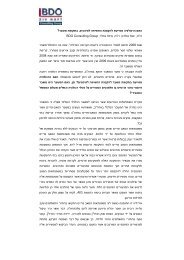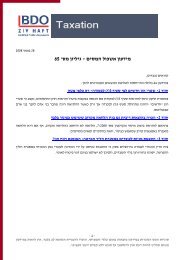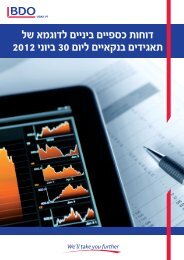preface
preface
preface
You also want an ePaper? Increase the reach of your titles
YUMPU automatically turns print PDFs into web optimized ePapers that Google loves.
BDO Israel<br />
DOING BUSINESS IN ISRAEL<br />
♦ Segment reporting - Israeli GAAP focuses primarily on the use of a primary<br />
and secondary format for reporting financial information pertaining to<br />
business and geographical segments. U.S. GAAP, on the other hand, uses a<br />
management approach for segment reporting, such that the enterprise<br />
component frameworks are evaluated by the chief operating decisionmaker.<br />
♦ Marketable securities - In Israel, investments in securities are classified into<br />
two categories (current and permanent investments). In the United States, on<br />
the other hand, investments are classified into three categories (held to<br />
maturity and trading, and available for sale investments). The categories<br />
prescribed in the United States have been adopted by the Israel<br />
Commissioner of Banks for financial statements compiled by banks.<br />
Differences also exist in regard to the application of statements of cash<br />
flows, and balance sheet presentation.<br />
♦ Capitalized financing costs - The accounting treatment is prescribed in<br />
Israeli Accounting Standard No. 3, pursuant to which financial costs - which<br />
might have been avoided had the asset not been built/established - are<br />
capitalized to qualifying assets as defined in this Standard. According to<br />
Accounting Standard No. 3, all other financial costs are charged to the<br />
statement of operations for the appropriate accounting period. The Standard<br />
adopts the principles prescribed by the American Standard (FAS 34),<br />
whereby it is obligatory to capitalize financing costs. Differences exist in<br />
the definition of financing costs and capitalization methods.<br />
♦ Fair value measurement and fair value option - Following the publication<br />
of FAS 157, the definition of 'fair value' under US GAAP has now been<br />
standardized. By contrast, Israeli GAAP does not provide a conceptual<br />
framework for fair value measurement, while IFRS offer more detailed<br />
definitions. Either way, the definition under US GAAP refers to a relative<br />
exit price as fair value, while its common concept under Israeli GAAP and<br />
IFRS is the entrance price-i.e. the price at which the transaction was<br />
concluded.<br />
Another issue is the option to measure financial instruments intended to be held<br />
at amortized cost, at fair value. This choice of accounting policy is<br />
unacceptable under Israeli GAAP.<br />
69

















